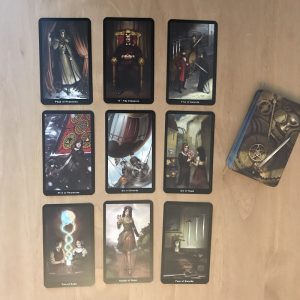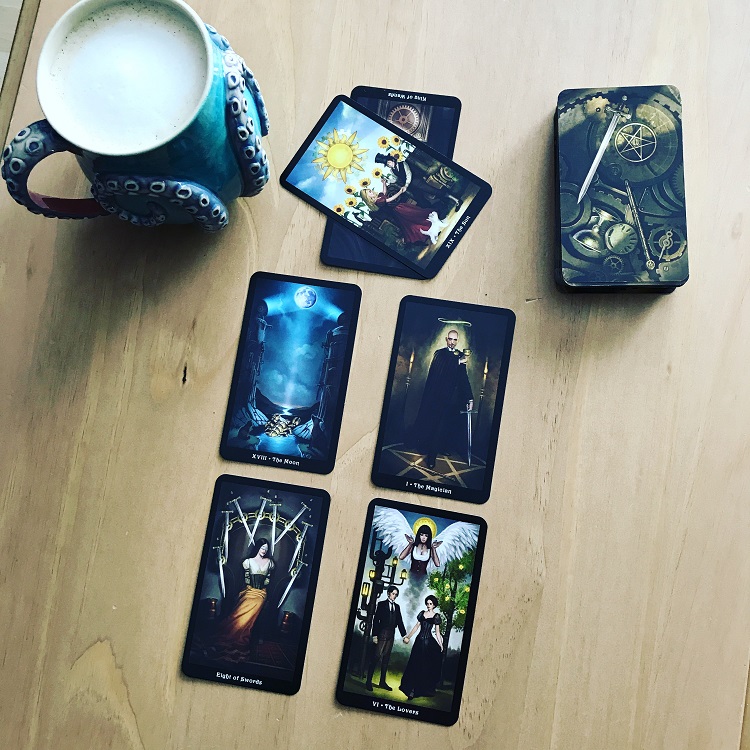Today’s reading uses Evvie Marin of Interrobang Tarot‘s Snowflake spread from her ebook, Eight Useful Tarot Spreads for Times of Change and Resistance. This is the fourth spread in the book, so we’re half-way through this little tarot challenge I’ve set myself!
I did this reading for myself. I’ve had a challenging couple days (which is why you didn’t see this blog post yesterday!) and I’ve been feeling a bit down on myself. I’m “too emotional.” I’m “too busy.” I’m “too focused on my work.” I’m “too stressed out.” I “don’t have good boundaries.” And on and on and on – all these stories about myself that come swarming in when I’m low on spoons and high on stress.
I opted to draw all of these cards, rather than intentionally selecting any of them, though I can definitely see the benefit of doing this spread with a chosen card, too.

Image description: A seven card spread. At the centre is the Queen of Cups. Clockwise from the 12 position are: Three of Wands reversed, King of Wands, Wheel of Fortune, The Lovers, The Hermit, and Two of Wands. The deck is the Steampunk Tarot.
The positions, as described by Marin.
0. My Center: How is the weather in my core?
- I Spy: A pet weakness. Something I perceive within myself as troublesome or flawed.
- I Listen: What does it have to tell me? What is the hidden strength in it?
- You Spy: A trait others see as one of my weaknesses.
- I Adapt: How can I best adapt and turn this into a strength? Is it truly a weakness at all?
- Vulnerability: The nature/expression of my softness and vulnerability.
- Power: The nature/expression of my fortitude and personal power.
I laid the cards 1-6, and then 0 at the centre last, but I flipped them 0-6. (I was also, for some reason, so trepidatious with this spread! Even though I always approach tarot from the perspective that if it feels wrong, we can add cards, flip cards, switch cards – it is our story, and tarot helps us tell it. I don’t believe that the cards ever force us into a story that feels wrong or bad for us, though I do believe that often the cards invite us to consider things from different perspectives. Anyway, despite that approach, I still felt hesitant. Afraid that the cards would confirm everything my insecurities have been telling me over the last couple days.)
So, 0. The weather in my core. Queen of Cups. I am feeling all my feelings. Yes. Indeed I am.
1, my weakness. Three of Wands, reversed. What am I trying to do? What are my plans, what are my goals? Why can’t I see through the fog? In this deck, the Three of Wands is looking out across a foggy bay, three lights to illuminate the gloom and a spyglass to help map out next steps. Upright, this card is so adventurous, optimistic, hopeful. In fact, I pulled this card earlier today, upright, and it felt like a lovely invitation to plan! But pulling it reversed here, I absolutely recognized my own belief that my lack of “good planning” is a weakness. If I just had the right plans, I would have solved my financial insecurity. If I had the right plans, I would have a more balanced life. If I had the right plans, my chronic pain would be better managed and my health would be solid. Although I bring an awareness of systemic and structural issues into my therapy work and my activism, there is a persistent intenralized belief that I am somehow creating all my own problems by not planning well enough.
2, the hidden strength. King of Wands. In all my anxiety about not having “the right plans”, I obscure the fact that I am accomplishing a lot regardless. The fog may be heavy, but I’m still moving forward. In the guidebook for the Steampunk Tarot, the quote for this card is, “If only we’d stop trying to be happy, we could have a pretty good time.” – Edith Wharton. And the core meaning is: “Someone who is driven by will, inspiration, and passion.” I may not have all the plans, but I do have will, inspiration, and passion.
3, what others perceive as a weakness. Wheel of Fortune. This one gets me right in my insecurities. The idea that people see me as flighty, fickle, unreliable. Flailing around – up today and down tomorrow.
4, adapting, turning this into a strength. The Lovers. Embrace my passionate self (echoing part of the King of Wands), and also trust the people around me, trust the connections that I’ve cultivated. I am a passionate person. I do spend a lot of time deep in my feels. It’s true that I can be up today and down tomorrow. But is that actually a weakness, or is that part of my hidden strength? The Lovers suggests that with the right people, it’s a strength. And those are the people I want to have in my life, and the people I want to be working with.
5, my softness and vulnerability. The Hermit. Too much time alone and I end up lost in anxiety, self-doubt, spiralling out into catastrophizing. The old stories about “always ending up alone” creep back. Too little time alone and I also end up lost in anxiety, self-doubt, and spiralling thoughts, dealing with newer stories about “always ending up a failure.” I need time alone. I need to bring softness to my solitude. And I also need to be aware of the difference between solitude and isolation, and my own vulnerability to old narratives about loneliness and rejection.
6, my fortitude and personal power. Two of Wands. The guidebook suggests asking, when this card comes up, “What feels bold? What ignites your passion? What connects to you to your spiritual roots?” Even when I’m not sure how to see the way forward, I’m able to access the bold, enthusiastic, passionate will that is such a strong part of me.
I found it interesting that the top half of the spread was all wands, the bottom was all majors, and that big cups energy in the centre. (Back when I was tarot blogging just for myself, I was over at Queen of Cups.) This tells me there’s a lot of movement and energy in my life right now, and a lot of that energy has to do with big, foundational changes. And I feel uncertain and off balance – which makes sense! This is a lot happening all at once.
I appreciate that this spread offers me a way to reframe what has felt like a weakness (my inability to handle all this swirling energy) into a strength (the ability to ground myself in connection and rely on my passion and inspiration). It’s storming out, but I’ve got plenty of fire.











